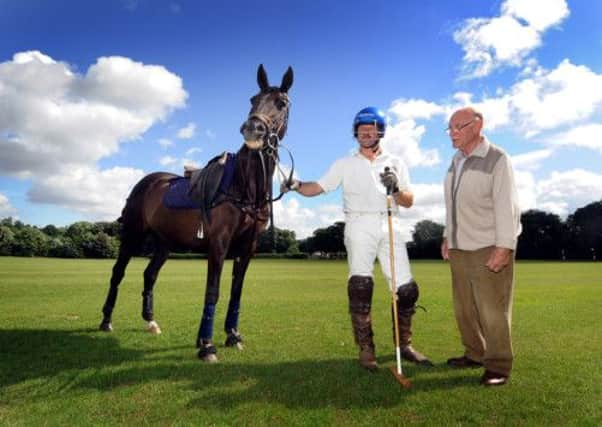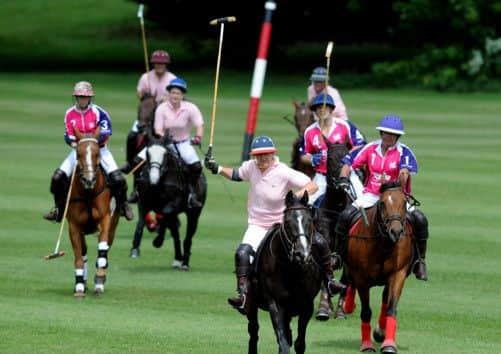Big hitters saddle up for a chukka or two


THE world ‘polo’, when it isn’t used to describe a mint with a hole, will for many people bring to mind a sport played on horseback by princes, handsome Argentinians and the wealthiest business types who love to mix with aristocracy.
The simple four-letter word also conjures up other words, such as Cartier and Veuve Clicquot, glittering sponsors of the game at its highest level. Spectators in blazers and white linen quaff champagne as players charge the length and breadth of an enormous field in pursuit of a small plastic ball they hit with a long-handled mallet toward a goal mouth with no goalie.
Advertisement
Hide AdAdvertisement
Hide AdAs the caviar and gravadlax slip down, the teams of four tear up and down, abruptly changing direction, occasionally colliding and sometimes charging so hard that they miss the ball entirely. The rules are not obvious, apart from the ones that say teams change ends after each goal and the team with the most goals wins.


Oh, and members and spectators might be expected to sally forth and trample down the divots left in the ground during breaks in the game.
Although it does push the boat out with marquees, a slap-up dinner and guests in finery at its annual Silver Jubilee charity tournament each June, Toulston Polo Club near Tadcaster is not about ceremony, formality, oligarchs and dukes, but friendliness and inclusivity.
Anyone with a horse, up to £850 for annual membership fees and enough energy can join – unlike the early days at Toulston, when membership was exclusively at the invitation of its founder William Riley-Smith, scion of the Tadcaster brewing dynasty, who’d installed the pitch so that he could pursue his sport in the grounds of the family home at Toulston Lodge.
Advertisement
Hide AdAdvertisement
Hide AdSet in 45 glorious acres a stone’s throw from the A64 and secluded by a ring of towering ancient trees, even some locals don’t know there has been a polo club at Toulston since 1913.
On a sparkling Sunday morning, horse boxes and lorries have arrived, and riders and grooms are preparing the animals. Members practice on Wednesday evenings and Saturdays and compete on Sundays. They’ve brought a small but enthusiastic crowd of supporters with them for an in-house tournament that will last around two hours and earn the winners a silver trophy. During the Easter to September season there are up to 21 trophies to be played for here.
A few players with better handicaps are competing elsewhere (Toulston has nurtured players who’ve gone on to international stardom) but most members have turned out. The small pavilion – regularly painted and cleaned by members – is buzzing with preparation of pots of tea and sandwiches presided over by Christine Gallagher. Robin Gallagher, her husband, is in charge of scoring and drawing up the order of play.
Players in white jeans, polo tops of assorted colour according to team, and those sexy long leather boots with thick knee caps stand at the ready. Picnic rugs and small children running about on the bank beside the pitch complete the bucolic picture. Each game is played in four seven and a half-minute segments or chukkas, and because the action is so fast and furious a player has two horses, which take part in alternate chukkas so one can rest in between.
Advertisement
Hide AdAdvertisement
Hide AdFrom the moment play starts the match is frantic, using the entire length and breadth of the 300 yard by 160 yard field. Players must not cross an imaginary line, intercepting the trajectory of a ball, instead riding in parallel with an opponent and racing them to the ball. Shoulder bumping is allowed.
This is the fastest ball sport in the world. Each team of four has a long-hitter/defender at the back, and a shorter hitter who may be less experienced at the front. A lot of the hardest work is done by the two players in the middle. You can see within a couple of minutes why anyone would get hooked by either playing or watching this sport. This tournament will end with a nail-biting draw followed by a rare penalty shoot-out before the team in dark pink carries off the silver cup.
It’s believed that polo has been around for 2,000 years, with the first recorded game taking place in 600BC, between the Turkomans and Persians (the Turkomans won). ‘Polo’ is said to have come from the word ‘pulu’ (meaning ‘ball’) used for the game in Tibet.
The Moguls were largely responsible for taking the game from Persia to the east, and by the 16th century the Emperor Babur had established it in India. In the 1850s British tea planters discovered polo in Manipur on the Burmese border with India, and they formed the first club at Silchar. The oldest surviving club is the Calcutta Club, founded in 1862.
Advertisement
Hide AdAdvertisement
Hide AdIn 1869 Edward ‘Chicken’ Hartopp of the 10th Hussars read an account of the game in The Field, and with brother officers organised the first English game – known then as ‘hockey on horseback’ – on a hastily-rolled Hounslow Heath. He drew up a few rules, but it was John Watson of the 13th Hussars, who formulated the first real rules of the game in India in the 1870s.
The first official match in Argentina took place in 1875, after the game was taken there by English and Irish engineers and ranchers. In this country the governing body of the sport is the Hurlingham Polo Association.
Today, around 77 countries play polo and the top countries are Argentina, the UK and the US, with China’s stock rapidly rising. Polo was an Olympic sport from 1900 to 1939 and has now been recognised again by the International Olympic Committee.
There are around 70 clubs in the UK, including university clubs, and four in Yorkshire.
Advertisement
Hide AdAdvertisement
Hide AdWilliam Riley-Smith, who at one point had 33 polo ponies, died in 1954 and the Toulston Polo Club eventually passed out of the family.
Jim Haigh, a former textile lecturer at Huddersfield Polytechnic who subsequently went into his wife’s family carpet business, took up the sport following doctor’s advice to relieve stress by doing some kind of sport. He had tried hunting in his youth and loved horses, so he joined the club in the 1970s, and bought it from a local farmer in 1992. He then put in a second polo ground on the site to give more scope for practice.
He has been a national official of the HPA for decades, and only gave up playing three years ago, aged 81, after a hip replacement.
“The biggest change in polo over the years is that the rules have been tweaked to make it more of a team game,” says Jim. “There has to be more passing of the ball now, which discourages showboating by the top players and gives everyone a chance.”
Advertisement
Hide AdAdvertisement
Hide AdJim’s son Josh, who can hit the ball at up to 150mph (the top Argentinian players like Adolfo Cambiaso can whack it at 200 mph), says: “It’s about the adrenalin. When the ball hits you, which it sometimes does and usually on the back, you don’t feel it immediately.
“The umpire stops play and asks if you’re okay, but you want to go on because the adrenalin masks the pain. It’s only later that you realise something hurts.”
Polo injuries have more often than not been to the face, and many players now wear a protective ‘cage’ attached to their headgear.
The more serious players may have four or five horses to cover a season and allow for injury. “But if you’re prepared to buy a failed racehorse for £400-£500 and train it up, then you can get a lot of fun and satisfaction,” says Josh. “Only a few years ago you used to see plane loads of Argentinian polo ponies being shipped over, but now the import taxes make that prohibitive.”
Advertisement
Hide AdAdvertisement
Hide AdClub member and highly competitive player Sarah Lloyd, has co-written a book to mark the centenary of Toulston Polo Club, with all its highs and lows including closure during the two world wars.
She demonstrates the one-handed control of her horse with the reins. “They are very sensitive to the slightest movement and pressure from your hand or legs. You and the horse are like one animal really.”
She’s 34, and a pensions administrator at Bradford Council. Her riding instructor mother Christine (who’s busy with the catering) taught her to ride, but she gave up between the ages of 16 and 28. Then she decided she wanted to try polo and bought her pony, Quinta.
“I spent six months learning technique with the help of an Argentinian trainer who lived nearby, and I had to build up muscle in my arms. I joined Toulston, and found it very friendly, very relaxed. They really look after you.
Advertisement
Hide AdAdvertisement
Hide Ad“I competed straight way, scoring three goals in my first game, and am now in my fifth season. During the winter I really miss it.
“Yes, you do need a bit of money to take part, but you don’t have to be wealthy and you don’t need to have a top quality horse to play well. The kit costs a few hundred pounds, plus club fees, and I pay around £80 a week for my horse in full livery.
“I borrow a second horse to compete with from another member who has several and is very kind. Quite a few members come from farming families, so it’s easier for them to keep horses at home.”
Jim Haigh is still club secretary, but he has now handed over ownership of Toulston polo ground to Josh and his sister Elizabeth, and hopes that the club will be continued well into its next century.
Advertisement
Hide AdAdvertisement
Hide Ad“The club is a great family, a proper country polo club that’s run by the members for the members,” says Jim. ”No-one is ‘better’ than anyone else, and people come simply because they enjoy the sport. That’s why I love it. ”
To buy a copy of 100 Years of Toulston Polo Club 1913-2013 by Sarah Lloyd and Robin Gallagher or visit www.toulstonpoloclub.com, email [email protected], or call 01422 372529.